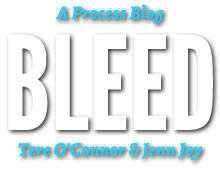10.17.12. The morning after the interrogation…
Standing at the ballet barre, the dancers run to the mirror turn, almost swoon and sweep arms bend over to rise and return to the barre. This is to be the opening refrain, the establishing shot as so many initial lines of flight come undone. The dancers run to leap to circle.
Tuesday is a day of trespass—Providence to New York, sculpture to dance, seminar to studio—of choreographic preoccupations. Returning to the studio, the detritus of teaching lingers in my mind. How do we sit, who sits where? How is knowledge produced? What does it mean to read critically? How do we watch closely with concern and interest? What kind of techniques and skills are required and which ones become so many limitations? Perhaps part of the work of these interrogations is to open up the spaces where discourse, talking together, critically, creatively, might happen. I hope. Can we attempt something provisional, even promiscuous in its reach?
Natalie and Heather watch Oisin, Silas, and Michael lie with raised legs on the ground. I think of Tere remembering his first viewing of Swan Lake as a child, of seeing no swans but other architectures, the trio, the triangle. A structure to add to the concern with line, duet and trio, established, danced, then dissolved, recomposed again.
Between the barre and the mirror. Of course, this space is just one of the transitional locations of Dance 2 resulting from complicated rehearsal schedules, classes, work commitments, economics, time. And yet, the effects of the studio participate in the viewing of this particular moment. The barre and mirror act as so many ciphers for the questions of training, of technique, of virtuosity called up in the dancing. To state the obvious—the dancers are all exquisite movers and performers—and yet the piece asks something more than simply the display of virtuosity; it invites a reflexive play with structure, with authorship, with meaning
They step to slide, to step, to slide. Side step, side step… Is this a rehearsal line along the barre or a chorus line. At some moments the dancers form two lines facing each other and the empty space becomes a column, a ghostly aporia, transposed across the space in different and shifting directions.
Natalie and Silas dance in distant proximity. My mind wanders as the density of movements overlap in the space. Three hold hands, barely touching each other. Often one faces away from the other during this precarious balance. Gestures collapse in distant proximity is this a portrait of intimacy?
Tere describes the dancers as witnesses inside the work, such that it is not collaborative in the same ways as Dance 1. The voice of the choreographer directs and conditions. From the periphery leaning against the piano he intones: “and”… “and”… The dancers continue. The choreographer’s voice becomes command, yet his words gesture toward a more open additive compositional quality. Stillness is immanence or latent texture. Now facing the audience, the dancers’ deep plies expose a vulnerability of throat as their heads fall back and arms sweep up. This constant accumulation of micro-gestures of fingers, of wrists, of neck, of hands, always transforms into torque and extension and movement.
Sometimes her hand is a claw and sometimes theirs is a tree and sometimes his is a tool for digging and sometimes it is pinched to judge scale relations and sometimes the hand is just a hand.
To hold. To touch. To look. To assist. I want to think about choreography as a series of infinitives that point toward and back and sideways simultaneously. Here repetition might escape some of its mimetic restraints to do more inventive reparative work. Or perhaps these many refrains generate what Jen Rosenblit describes as the “hot spots” in the space, a more phenomenological and affective rendering of the spatial and temporal through temperature and tone.
They walk on relevé. As Heather’s arms open toward an unrequited hug she makes visible a soft nebulous architecture within the space of the studio. This is not pantomime but the body taking on a shape in relation to an imagined force or form; moving to foreground the background.
—Jenn Joy
